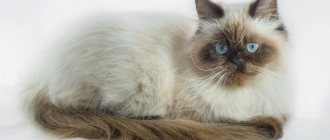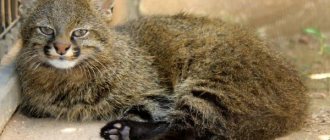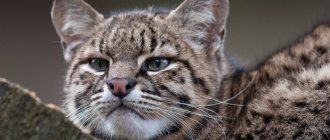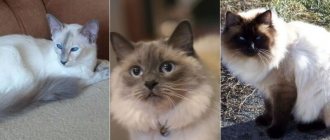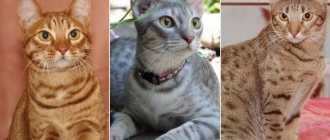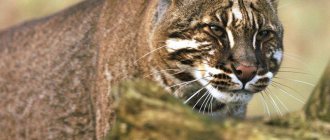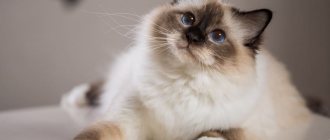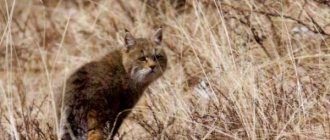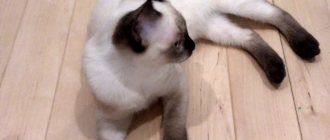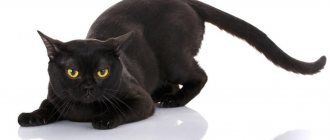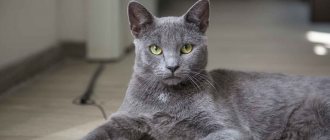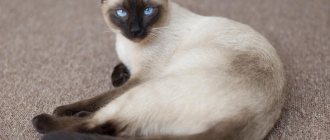Himalayan cat - Persian and Siamese in one bottle
Contrary to their name, Himalayan cats are not related to the mountains of the same name and were developed in the United States by crossing Siamese and Persian cats.
In Europe, the cat is known as the Persian color-point. Himalayan (as well as Siamese, acromelanistic or pointing) is a characteristic color in which the protruding parts (muzzle, ears, paws and tail) are darker than the color of the whole body. Although not all felinological associations recognize this breed, considering it only a variety of the Persian cat, it is in demand among professional breeders and hobbyists.
History of the origin of the Himalayan cat
Throughout the 20th century, attempts to breed a long-haired cat with a colorpoint color were made repeatedly by breeders from the USA, Canada, Great Britain and Sweden. So, in the 1930s, it was possible to cross a black Persian male with a Siamese female, but as a result, short-haired kittens were born that inherited the color of their father. Only in the 1950s, the experiments of the Canadian B. Boret, and in parallel with him the American M. Goforth, made it possible to select a breed with the body type and coat of a Persian cat and the color of a Siamese.
In 1957, the Himalayan cat was recognized by the international Cat Fanciers' Association (CFA). The breed got its name in honor of the Himalayan rabbit, which has a similar color.
However, in 1984, due to the similarity of exteriors, the Himalayan breed was merged with the Persian, receiving the status of a “subbreed” or “division” (color group). TICA (The International Cat Association) holds the same opinion, considering Himalayan cats in the same group with Persian and exotic shorthairs.
Other felinological associations (NCFA, AACE, ACFA, CCA, CFF, UFO) classify the Himalayan as a separate species with its own breed standard.
Description of the breed
The Himalayan cat is a large, long-haired breed with short, muscular legs. What gives her a special charm are her large round eyes of an inexpressibly beautiful blue color, sharply contrasting with the dark “mask” on her wide muzzle.
Standard
- Body: stocky, equally developed in the shoulders and rump, level back. The legs are short with highly developed muscles, straight. The male weighs about 4 - 6 kg, females 3 - 4.5 kg. A very short neck flows smoothly into the body.
- Head: wide skull, powerful jaws, correct bite. The shape of the head is round, smoothed. Cheeks are full. The profile is short. The forehead, nose and chin are located on the same line.
- Ears: small with rounded tips, set at a considerable distance from each other.
- Eyes: round and large, widely set, bright blue.
- Tail: Proportional to body length, covered with long hair.
- Coat: long, thick, shiny. The frill on the neck turns into a train between the legs. A large number of colors.
Colors
Reference! The characteristic color appears only in the second or third year of a cat’s life.
The most common ones include:
- seal point is a cream, sometimes reaching light brown, color of the body and neck with dark brown markings on the prominent parts of the body.
- flame point or red point - protruding parts are fiery red
More rare colors:
- tortoiseshell - walrus colored markings interspersed with cream and red spots.
Important! Usually only females are tortoiseshells; a cat of this color is rare and cannot have offspring.
More valued than others:
- lilac point or frost point - the color of the markings is bluish-pinkish (lilac).
- tabby point or lynx point (marbled or brindle) - the fur on the body of such cats is very light, and the markings have clearly visible stripes of any color (walrus, blue-gray, milk chocolate). The mask has an M-shaped pattern on the forehead, plain ears with a light spot on the outside.
Health
Himalayans have relatively strong immunity. Among the diseases characteristic of the breed are polycystic kidney disease. Also, due to the “flattened” muzzle, pets may be bothered by increased lacrimation.
Life expectancy is on average 12-14 years, but there are also long-livers. The health and longevity of blue-eyed fluffies directly depends on the conditions of detention, care, and proper feeding.
Character of the Himalayans
Being a cross between Persian and Siamese cats, the Himalayan has combined the features of its “ancestors” in its character, having inherited curiosity from the Siamese, and a good disposition and laziness from the Persians.
Himalayans are excellent companions for both adults and children. Their affectionateness and love of love is manifested in their special affection for their owner. Such cats can treat strangers with wariness, but not with aggression, and after getting to know each other more closely, they will shower them with their attention.
The Siamese gave the breed a love of games. The Himalayan loves toys and paper balls.
An interesting feature of the Himalayan cat is that they meow little, so they will not annoy you with loud demands. An important advantage is that the animals easily get along with other pets.
Thai
Another close relative of the Siamese is the Thai cat. They originated from Thailand. Previously, the Thais guarded temples and lived at the court of the Siamese dynasty.
In their gracefulness they even surpass the Siamese. This breed has a playful disposition and is active until old age. They are very attached to their owners, which reminds them of a dog. These animals are not inherently timid; they are famous for their fearlessness.
Note: The Thai breed is suitable for lovers of temperamental and active animals.
He has a playful character and curiosity.
Beneath their fur they have a strong body with well-developed muscles, and they are slightly larger than their Siamese counterparts.
Possible problems
The Himalayan cat has long, thick hair, so people with a tendency to allergies are directly contraindicated to have one. The joke “In a house where a cat lives, everything is a cat” is more relevant than ever in the case of the Himalayans. Therefore, “clean people” are also unlikely to like the animal.
Such a pet is not suitable for those who want active games with a cat or often move from place to place, on business trips and travel.
Wool
Especially careful care is required for the luxurious wool of the Himalayan. It consists of combing your pet daily, preferably in 3 steps: first with a wide-tooth comb to remove large tangles, then with a more frequent comb and, finally, with a special brush to remove dead hairs. The most problematic areas are the neck, paws and the area under the tail, where the fur rolls up the fastest.
The issue of water procedures causes a lot of controversy. Some argue that the coat of a Himalayan cat needs to be washed with shampoo almost weekly, while others consider bathing once every six months to be sufficient. It is wise to take a closer look at your pet and bathe it as needed, taking into account its lifestyle and living conditions.
Nutrition
With an excessive and unbalanced diet, Himalayans are prone to gaining excess weight. It is recommended to choose dry and wet food from the premium and super-premium segments, intended for cats with long hair: they promote better digestion and removal of hairballs from the stomach. In addition, it is advisable to use malt paste to remove trichobezoars.
From natural products, low-fat protein foods (chicken, beef, turkey) and complex carbohydrates (various types of cereals, sprouted wheat) are welcome.
Caring for ears, eyes and other body parts
The breed is characterized by increased tearfulness, so hygiene procedures should include daily washing with a damp cotton pad. The direction of movement is from the eye to the nose, otherwise inflammation cannot be avoided.
When caring for your pet's ears, remove excess wax with a cotton swab. It is possible to use special ear drops.
It is necessary to trim the claws 1-2 times a month, but the procedure can be performed less frequently if the cat is accustomed to the scratching post.
Walking the pet, living conditions in the apartment
The Himalayan cat is a “domestic” animal in the full sense of the word. Ideal for apartments or private houses. However, too small and cramped spaces will put pressure on the pet’s psyche and can cause neuroses and even aggression. For a good mood and well-being, a cat needs space and the opportunity to explore all corners of the home.
Due to the structure of the nose, problems with the animal’s thermoregulation are possible, so it is necessary to maintain an optimal temperature at home (20-22°C) and shade the room on a hot, sunny day.
If the owner is determined to walk the fluffy beauty outside, he must be prepared for more frequent bathing, the use of anthelmintic drugs and mandatory vaccinations.
Keeping at home
Brushing and bathing
Himalayan cats have long and thick hair, so they require daily brushing to avoid the formation of tangles. For this correct procedure you will need three different combs. First with sparse teeth, then with frequent ones, and finish with a brush with natural bristles.
It is also advised to periodically bathe animals to wash away fatty deposits from the fur. Himalayan cats are calm about this procedure and even love it. And don’t forget to trim your nails once every 2-3 weeks.
ATTENTION! Himalayan cats experience stress in small, confined spaces.
Diet
Himalayan cats are unpretentious in food. But they are prone to obesity, so monitor portion sizes carefully.
Veterinarians recommend feeding cats premium food for long-haired cats. But you can also give them natural foods: lean meat, sea fish, dairy products, vegetables, eggs, cereals. Don't forget to add vitamins to your diet. Plant special grass, oats, and wheat for them.
ATTENTION! Eliminate salty, sweet, peppery, smoked, fried and fatty foods from your diet.
Give milk only to young cats, and cottage cheese, kefir, fermented baked milk, and yogurt are more suitable for an adult cat. It is necessary to feed them fruits; they love apples.
Breed card
| Characteristics of a cat | Notes | |
| General information | The cat looks like a Persian breed | Not everyone recognizes Himalayan cats as a separate breed. |
| Character | Calm, balanced and friendly | Fairly playful, but not hyperactive |
| Appearance | The body type and length of the coat came from the Persians, and the point color from the Siamese. | Thick, light coat with dark spots on the face, ears, tail and paws |
The final color is formed by 2 years of age.
How to choose a Himalayan kitten
The choice of a Himalayan kitten is complicated by the fact that the point color is finally formed only by the 2-3rd year of the animal’s life. Until 3 months of age, it is difficult to discern even a hint of a mask and a “scorched” effect on the tail and paws in the white fluffy ball. To avoid getting into trouble, you should pay attention to the parents of the future pet and carefully study the documents confirming the pedigree.
When buying a kitten, also take into account:
- physical form and appearance of the cat,
- conditions for keeping animals in the nursery,
- age of pets.
The price of the issue depends on many factors: color, gender, reputation of the nursery, “title status” of the parents. A kitten that can perform at exhibitions cannot cost less than 10,000 rubles.
The purchase is completed by the issuance of documents by the seller. Package includes:
- contract of sale;
- kitten card (exchanged for pedigree);
- veterinary passport, which indicates the vaccines administered and the dates of deworming.
Breeding
For successful breeding work with the Himalayan cat, high quality stud cats and cats are required. Not only the external, exhibition characteristics of the animal are very important, but also a strong pedigree. This means that the quality can be traced over several generations and the necessary characteristics are well fixed in the genotype. It is from such animals that good kittens will naturally be born. Often a recessive gene is responsible for the desired color, so inbreeding is common in Himalayan breeding, i.e. mating within the same bloodline.
Cats can be bred once they reach sexual maturity (approximately 8–9 months). The number of kittens in the litter is from 3 to 6.
The greatest variety of colors in litters comes from Himalayan cats with tortoiseshell (tortie-point) and blue-cream-point colors. So, kittens can be born from a torty point female and seal point males: seal point, blue point, flame point (males), cream point (males), tortie point (females) and blue cream point (cats).
Today, the number of nurseries involved in breeding Himalayan cats is growing. Here are examples of some of them, found as a result of simple surfing on the Internet:
Breeding and care
Caring for this breed of cat must be done carefully and daily. You need to be prepared for the fact that you will have to comb out thick and long fur well. And even despite daily care, white fur will be everywhere - on the floor, on furniture, on clothes, you will just have to come to terms with this, or not get such a cat. If the wool is not combed out, then very quickly it will become tangled in tangles, which will only need to be trimmed. For regular combing, use a comb with sparse teeth, and for cleaning dead hair, use a comb with thick teeth.
Himalayan cats love to swim, so water treatments should be carried out once a month, since the washing process removes excess oil secreted by the sebaceous glands.
After this procedure, the skin begins to breathe, and the fur pleases with its well-groomed appearance. For bathing, it is recommended to use only good quality shampoos designed for the care of long-haired cats.
The animal's face also requires attention. Due to the presence of a snub nose, these cats have constantly watery eyes, so they need to be wiped daily with a damp cotton swab and the tear ducts washed. You should also clean your ears once a week.
Long-haired cats, maintaining their cleanliness and licking themselves, gradually accumulate hair in the digestive organs, so that in the future there is no regurgitation of hairballs, you need to add hair-removing products to the diet, sold at a veterinary pharmacy.
The diet should be compiled taking into account the age, weight, health and gender of the animal. Small kittens need to be fed up to 4 times a day, from the age of six months - up to 3 times, in a one-year-old - two meals a day. Himalayan cats tend to be overweight, so it is important to monitor the quantity and quality of food they consume.
It is not recommended to give them natural food, but if there is a desire to feed them with food, then the selection of the diet must be approached very responsibly, since these cats have sensitive digestion.
Therefore, it is much more convenient to give Himalayan cats ready-made dry or wet food of high quality.
Mating of Himalayan cats is recommended no earlier than reaching the age of one and a half years. Pregnancy and childbirth are mostly standard and without complications. The average number of kittens in a litter is three; it is recommended to allow a cat to mate no more than twice a year. These animals are excellent parents; the most important thing is to provide them with control and increased nutrition. Kittens of the Himalayan breed look like plush lumps, being born completely white, they gradually change color, which is finally formed by the age of one year.
Interesting facts about the breed
- The gene responsible for pointing (Siamese, Himalayan) color is recessive in relation to the dominant gene for non-Siamese color. This means that both parents must pass on the gene in order for the kitten to have its external manifestation.
- The blue color of the eyes of Himalayans is due to the low level of melanin in the cells of the iris.
- Persians are the only cats in the world that have a flattened skull, like pug bulldogs. This feature was passed on to the Himalayan and exotic shorthaired Persians. However, there is a variety of Himalayan with a more traditional - pointed muzzle.
The Himalayan cat is ideal for those who are looking for a loyal friend, curled up comfortably on the owner's lap. The lucky owners of these cats will not have to worry about the fact that the pet will not get along well with other animals, meow loudly and be a nuisance in every possible way. The only caveat is the hassle of caring for the luxurious wool of the Himalayans.
Himalayan cats: characteristics, varieties, choice and care rules
join the discussion
Share with your friends
Anyone who equally appreciates the charm of Persian cats and the splendor of Siamese cats will find a lot of pleasure if they become the owner of a Himalayan cat. This breed combines all the advantages of Siamese and Persians. In order for your pet to have a long life, and for him to delight you with his appearance and affectionate disposition, you need to take proper care of him.
Possible health problems and life expectancy
Himalayans generally enjoy good health. Their problems are similar to those of Persian cats. Due to the structure of the nose, you can often hear heavy breathing and sometimes snoring, but this is normal.
This breed is usually diagnosed with:
- Respiratory diseases;
- Eye diseases;
- Polycystic kidney disease;
- Obesity;
- Skin diseases.
Cats of this color are more likely to have hernias than others. Kittens may be born with skull asymmetry or the wrong number of toes. Individuals with strabismus are also observed, which is often confused with slanting.
If you notice lethargy in your pet, loss of appetite, excessive discharge from the eyes and nose, vomiting, or abnormal bowel movements, contact your veterinarian immediately.
With proper care, cats of this breed live 13-15 years.
Description
The Himalayan cat, despite its “geographical” origin, is of American origin by name. It was in the USA in the middle of the last century that they crossed the Siamese cat and the Persian cat. In the USA the new breed was called Himalayan, and in the UK Color Point. Both names have a right to exist.
In a cross between a Siamese and a Persian, corresponding hereditary material was found, as in the Himalayan rabbit, which has light hair on the body with dark areas on the ears and limbs. At the same time, the name color point precisely suggests such features of the cat’s color.
The Siamese-Persian mix harmoniously combines the features of one and another breed. The characteristics of both ancestors are clearly visible in the cross. From the Siamese, the Himalayan cat got bright blue eyes and characteristic color features, and from the Persian - beautiful fluffy fur and an upturned nose. The weight of a representative of this amazing breed usually ranges from 4–6 kilograms, although some adult individuals have a larger weight. The breed standard assumes the following features:
- round head shape;
- prominent cheeks;
- the muzzle is wide and flattened;
- the ears are small and set wide apart;
- blue eyes;
- snub nose, with open nostrils;
- strong physique and a pleasant, slightly prominent belly;
- short legs;
- long fur with thick undercoat;
- there is a beautiful “collar” on the neck;
- bushy tail;
- there is a dark “woolen mask” on the muzzle.
A mixture of Siamese and Persian cats is very bizarre in appearance, all the more attractive to connoisseurs of the Himalayan cat breed. On average, their life expectancy is about 12 years. This is approximately how long the owners will be able to enjoy the company of their furry friend.
Burmese
Burmese cats were bred by French breeders in 1925. Outwardly, they resemble soft toys: fluffy with big blue eyes.
A distinctive feature of the Burmese are the “gloves” on their paws. She differs from the Siamese in her calm disposition, she can easily find something to do on her own, has a calm character and is moderately energetic. Representatives of this breed are good at feeling the mood of their owner: they can calm a choleric person or lift the mood of a melancholic person.
Character traits
The Himalayan cat is not a creature that will calmly tolerate the absence of human society. Unlike many of its brothers, this animal is strongly attached to its owners, as well as to the house in which it lives. From time to time, the pet will attract attention in every possible way in order to receive another portion of affection. He loves to sit on your arms, showing his friendly disposition. He really likes to be petted. If you need to remind a person of his needs, the cat will not only look into the eyes and rub against the legs, but also meow quietly.
The Himalayan cat patiently endures the fun of children, without exposing its claws or using its teeth. This happens only if she gets hurt. If the fluffy beauty doesn’t like something, she will not take revenge, like a Siamese, but will simply go to a secluded place where she will not be bothered. In order not to feel lonely, the pet can follow its owner from room to room. But at other times he is attacked by laziness, he can lie on the sofa or windowsill for 20 hours, being immersed in deep sleep. With this behavior, the “Himalayan” strongly resembles his ancestor on the Persian line, although still the representative of the “new breed” is much more active.
A cat can play with a toy for a very long time, especially if its beloved owner is nearby. At the same time, this animal will never play pranks, raiding curtains and cabinets, as well as conquering other “peaks”. Cats subtly sense the mood of their owners and listen with pleasure to what they are told. Sometimes it seems that animals really understand human speech.
However, they do not like noisy company. There is no rush to enter a room where there are many people. Going outside is not for them. They are more comfortable in the house, among those they know well, than in the open air.
Foreign White
Foreign White is a breed that is the result of the crossing of a Siamese and a solid white domestic cat. That is why these cats are also called white Siamese or white oriental shorthair.
The homeland of Foreign White is England. It was there that about 50 years ago, the famous geneticist Patricia Turner looked at an overexposed photograph of a lilac Siamese cat and came up with the idea to breed an all-white cat of the oriental type with blue eyes and without hereditary deafness.
In its temperament, this breed resembles a dog. Very active: they love to chase a ball, bring toys in their teeth, etc.
Note: Foreign White really does not like being alone, so if you are often not at home, make him a friend.
All of the above breeds are very similar to Siamese cats. And you will certainly be able to choose a suitable pet for yourself without any problems.
Thank you for the article, but I still haven’t found the name of the breed of my cat here, moreover, many people on the Internet ask the question everywhere and even attach a photo with a similar appearance and description of the character of my cat, but they also don’t find the answer... So What kind of breed do we have? Description by external features: large; noble appearance; long-haired (after sterilization it became like a plush toy), wool like cashmere (very pleasant to the touch); there are white socks and gloves, a symmetrical color, even on the paw pads (phalanxes) there are strictly alternating colors (pink/black); the muzzle is not flat or narrow; the eyes are very expressive, bright blue, spherical; the ears are not pointed, but triangular; the color is smoothly flowing: the muzzle is black, turning into brown towards the forehead, then dark brown, then up to the ears of a stunning chocolate color, going down to the body the colors also change to opal (the main color), on the back along the body fading tones descend from black to chocolate, then fell again, a bright white apron begins to the belly, also white there is a chic mustache and a very impressive jabot, a black (fluffy) tail. Description by character: faithful, very clearly loves only one person from the family, although he is in contact with all its members; touchy, but not conflicting, but very jealous of other four-legged animals (does not tolerate competition, if the owners do not allow another animal to survive, she will defiantly leave the room) and prefers to be in the company of her owners, paradoxically, but loves independence; affectionate (doesn't even let her nails out); requires attention and even spends the night with the owner; “sings” when he eats and offers it to everyone, brings food to where there is a person, does not like to eat food alone; she is picky about food and tries to achieve her favorite dishes with excessive affection; natural adaptability manifests itself in extreme situations (for example, on the street); shy (will never enter a room where the toilet is in sight, she will wait for the moment when everyone is distracted), tactful (feels a person’s mood); calm and peaceful, lazy (loves to sleep very much), plays when she gets attention or when something happens to her. Perhaps some of this description is not an obvious characteristic of this or that breed, but is personal traits, but for the most part I still think it is obvious. If you have an idea what kind of cat breed this is, then I will be glad to hear the answer, we just always thought that it was a Neva masquerade cat, everything seems to be similar, but the color (although there are enough shades in this breed) is not as interesting as that of our Musya
Types of colors
Kittens of the Himalayan breed do not have a distinct color. Their “color” seems more uniform than that of adult cats. The final coloring appears only at two or three years of age. The spots on the paws, tail and face come in different shades. There are Himalayan cats of the following colors:
- with cream spots on the fur;
- with lilac;
- with redheads;
- chocolate colors;
- gray;
- blue color.
Breed standards require the presence of a dark mask on a basic light background, not extending beyond the “face”. Sometimes the dark parts of the color have stripes or spots of a different shade. The most valuable are chocolate and lilac colors on a light background - cream or white.
Colors
The main color of the Himalayan cat is always white or cream, and the points, which are located on the face, tail and paws, can be of different shades. The most common colors are black, chocolate, brown, lilac, blue and red points. According to breed standards, the contrast mask on the muzzle should be dark in color and have clear contours that do not extend onto the neck and chest.
- Color point - a light-colored body with contrasting contours of a darker color;
- Links point - there is a bright mask on the muzzle, vertical stripes form the letter M on the forehead, there is a dark edging around the eyes, the inner surface of the tail and ears is lighter than the outer surface.
Himalayan cat - a mix of Persians and Siamese
Having met a Himalayan cat for the first time, ordinary lovers of representatives of the noble cat family usually begin to mistakenly attribute it to either a Persian, or a Siamese, or even a Neva Masquerade.
The secret of the origin of the breed lies in the careful work of breeders who decided to cross representatives of two venerable and well-known cat families: the royal Persians and the independent Siamese.
History of the origin of the breed
The Himalayan cat is an artificially bred and very unusual breed. Both the British and the Americans were involved in its creation in parallel and completely independently of each other. The breeders chose the Persian cat and the Siamese cat as producers.
From the resulting litter, only fluffy cubs with a pronounced coloring characteristic of the Siamese were selected. Then only such kittens were bred. As a result, a breed appeared whose representatives are characterized by traditional “Persian” wool with all its advantages and disadvantages and an unforgettable “Siamese” color, which is also called color point.
First success in 1950 After many years of efforts, as a result of crossing Persian and Siamese breeds, a breeder from the USA, M. Goffort, achieved success.
It is worth noting that, as a result of selection, the British have produced cats that are somewhat different in external characteristics: their muzzle is visually more elongated, and the color is the same characteristic, but more intense “Siamese” color.
A mixture of a Persian and a Siamese cat, a separate breed called the Himalayan cat was officially recognized only seven years later. Previously, she was phenotyped as a Persian cat.
The Himalayan and Persian breeds were combined into one by the Cat Fancier Associations (CFA) in the 1980s. Breeders opposed to this move decided to create their own new association called NCFA, where “Himalayans” and “Persians” are still considered and counted separately.
Personality of the Siamese cat
The character of Siamese cats is quite independent and obstinate; if she is offended, she will remember it for a long time and will emphasize this in every possible way. A Siamese cannot be forced to do something if she is against it. To defend her rights, she will hiss and may release her claws.
Important! Of all the family members, she will choose one and will express love and devotion for the rest of her life, but with a reciprocal attitude towards herself.
The peculiarity of the characteristics of the Siamese breed is that they do not show aggression towards children, but do not allow them to bother them, carry them in their arms, or drag them by the tail. In response, Siamese may scratch the offender.
In photographs of Siamese, not only the features of a beautiful appearance are clearly visible, but also the independent, proud character of a wayward animal is reflected.
For all its complexity of character, Siamese cats have advantages and disadvantages of character that make them unlike other cat breeds.
Advantages of the breed:
- They are distinguished by their unique appearance, they are inquisitive and quick-witted;
- Loyal and attached to its owner for its entire life;
- She can endure long-term loneliness painlessly and can find entertainment for herself.
- You can, with affection and perseverance, teach not to steal from the table;
- The cat sheds little, so there is no need to remove the cat's fur often.
- Siamese cats are accustomed to scratching posts and do not damage furniture or wallpaper.
- she will not show aggression if she is attentive to herself.
Disadvantages of the breed:
- Siamese require a lot of attention and communication, but only at will;
- It does not forgive the offense for a long time, and takes revenge on the owner until he receives justice;
- Has impulses of jealousy and can be expressed in any way, even aggressively;
- Doesn't get along with small children.
Description of the breed
Due to the fact that the “Himalayans” are a hybrid of Siamese and Persian breeds, the description of the representative cats has typical characteristics of both breeds.
Breed standard
Himalayan cats are characterized by the following distinctive features, which do not allow knowledgeable fanciers to confuse them with other breeds:
- stocky, muscular, round body with a low chest;
- Almost everyone has a well-rounded belly;
- there must be a long, thick, soft, beautiful coat of silky texture, inherited from the parent breeds, and a very fluffy tail;
- the beautiful dark “mask” on the muzzle should in no way extend onto the neck;
- short limbs;
- the head is round, the cheekbones are also large and round;
- the nose is wide and short.
Thanks to these physical characteristics, cats also develop unique behavioral habits. Due to their short legs, these cats do not have the excellent jumping ability characteristic of almost all cats.
Color
The unforgettable color of Himalayan cats was obtained due to the corresponding mutation of the genes responsible for the color of Siamese cats. As a result of selection activities, the enzyme (tyrosine), responsible for the production of melanin, began to be produced depending on the ambient temperature, so pigments are practically not produced in most areas of the body. The only exceptions are the furred and protruding parts (at the tips of the ears, tail, tips of the paws, muzzle). Hence the coveted Siamese color.
The color schemes of the Himalayans can be different. Usually the color of the spots depends directly on the color of the base coat. For cats with a white or cream body, the mask on the face, ears and tips of the paws will be dark brown, cream or chocolate.
The most popular shades among breeders are blue and lilac seal point (with brown paw pads), chocolate (darker tones than seal point, and pink paw pads), red and cream.
Due to the recessiveness of these genes, kittens of lilac and chocolate colors are born only in cases where breeders breed two sires of the same color.
Intrabreed varieties of Persian cats
Within a breed, animals differ in color.
- monochromatic cats;
- with partial coloring;
- colored within points;
- shaded;
- smoky tabby.
Black
A distinctive feature of the color is the complete absence of white and gray hairs and light undercoat. The eyes are copper or orange in color, the fur is long, especially in the collar area and on the chest.
The undercoat is thick. The pads are brown or black in color
White
The Persian cat, which has a snow-white coat, is characterized by:
- long, soft and smooth fur;
- eyes are blue, orange or multi-colored;
- short fluffy tail;
- pink nose and paw pads.
It is believed that white cats with blue eyes are deaf.
Blue
The blue Persian kitten initially has a tabby color, which later becomes invisible. Fur up to 10 cm long is soft and silky. The undercoat is thick. The paw pads, upturned nose and eyelids are grey-blue. The characteristic eye color is copper, the ears are small, and the fluffy tail is also small.
Cream
The eyes are copper or “orange” in color, the fur is unusually long, the eyelids, paw pads and nose are pink. Everything else is standard for the breed. The fur can have a creamy or brighter copper tint.
Red
The fur color is brighter than that of the cream Persian cat - orange-red. It can be plain or with “stains” characteristic of tabbies. To match the fur are the frames of the eyes, paw pads and nose, which has a characteristic upturned appearance. The eyes are also orange, an “orange” hue. With its muzzle the cat resembles a Pekingese.
Smoky
The smoky color of the Persian cat can have different tints:
The main feature and advantage of this color variety is the silver-white undercoat. The fur is long, soft and silky. The paw pads, nose and eyelids of dark-colored cats are black, while those of light-colored cats are light, matching the coat.
The main wealth of smoky “Persians” is their characteristic fluffy tail, luxurious mustache and delightful shimmer of fur when moving.
Cameo
The unusual color of the Persian cat is characterized by a red or cream tint at the tips of the fur, while the whiteness of the undercoat becomes noticeable only when the fluffy beauty moves. The fur is distinguished by its length, the paw pads and small nose are pink. The eyes are copper or orange in color.
Color point
They were identified as a separate breed - the Himalayan: Persian cats with a Siamese color. The main “background” is white or ivory, the eyes are usually blue. The tail is distinguished by its splendor.
Character
They say about the Himalayan cat breed that they have an extremely wonderful character. Cases when it is recommended to take a cat as the only pet in the house and stories about amazing stubbornness are clearly not about them. They are friendly, energetic and emotionally balanced with other animals.
Any of the Himalayan breed loves to play immensely, so the owner will have to allocate minutes of his free time to communicate with his furry pet.
These cats are very attached to their owners, you need to be mentally prepared for the fact that you will be accompanied everywhere in the house by a charming ball of fur, taking all possible part in all matters and concerns.
Due to the fact that this type of cat is long-haired, their care will not be any different from the care that other breeds with long hair require.
The peculiarities of keeping these cats consist of daily combing with a sparse comb and weekly frequent brushing. These are basic procedures that must be carried out almost automatically, otherwise there is a risk of the fur becoming tangled.
To avoid problems with stool, it is recommended to give hair removal medications daily. By the way, these cats love to swim, which is rare among this furry tribe.
Do not forget about the relationship with the Persians: the Himalayans, due to the structure of the nasopharynx, are characterized by most problems associated with the respiratory tract. Therefore, in order to avoid all sorts of troubles, they simply need regular care of their nose and eyes.
Feeding
Veterinarians recommend feeding Himalayan cats, like any other feline, high-quality, balanced food, taking into account their tendency to obesity.
Feeding with natural products is possible, but this creates not only unnecessary organizational problems for the owner, but also does not guarantee the provision of the basic set of necessary vitamins and microelements.
When it comes to treats, fresh grass, and everything else related to your pet’s diet, you should listen to the advice of your veterinarian.
Health
Most of all, Himalayan cats suffer from eye and respiratory diseases. They are typical for all types of cats that are in the same group according to the structure of the organs of the respiratory system.
To maintain the health of cats and your own nerves and money, it is important not to forget about a balanced diet and regular care for your pets.
The average life expectancy for cats living at home is about 12 years.
Features of care and maintenance, nutrition
Selection work has affected the character and behavior of the Persian cat. The main feature is the complete lack of survival skills in street conditions. An abandoned or lost animal is doomed to death.
But in a home environment, the cat feels like a queen. And as befits a true queen, she needs care. Long, thick fur requires care: daily combing, otherwise the fur will roll up and tangles will form. You will also have to put up with the fact that cat hair will appear everywhere in the house - “Persians” shed almost all year round.
In addition to the inconvenience for the owners, the animals themselves suffer from this: while licking themselves, they swallow a lot of hair, which can roll into a lump in the stomach and clog the gastrointestinal tract. It is necessary to give special medications that remove hair from the body painlessly. Many people give Persians a beautiful haircut.
Self-walking is not for Persian cats. If you walk it, do so only on a harness, so that the cat does not get plant debris or burdocks on its fur. After a walk, you need to comb it out immediately.
From early childhood, a kitten must be taught to bathe. If you wash your cat twice a month with special shampoos and conditioners, you can make brushing easier. Detergents should be chosen with medicinal herbs, and tinted shampoos are recommended for black cats. To prevent your pet's fur from becoming electrified, after it has dried, it must be treated with an antistatic spray.
